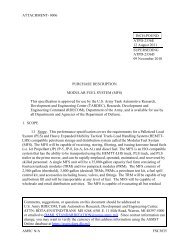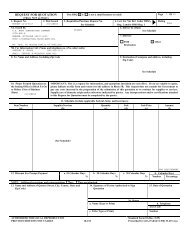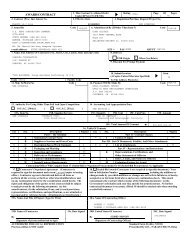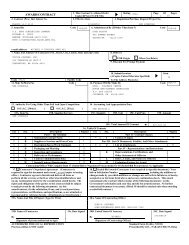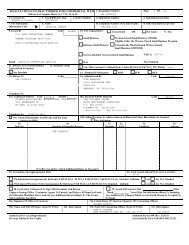draft beb rfp - TACOM Procurement Network - U.S. Army
draft beb rfp - TACOM Procurement Network - U.S. Army
draft beb rfp - TACOM Procurement Network - U.S. Army
Create successful ePaper yourself
Turn your PDF publications into a flip-book with our unique Google optimized e-Paper software.
CONTINUATION SHEET<br />
Name of Offeror or Contractor:<br />
Reference No. of Document Being Continued Page 106 of 170<br />
PIIN/SIIN W56HZV-12-R-0445<br />
MOD/AMD<br />
Items susceptible to corrosion or deterioration shall be provided protection by means of preservative coatings, volatile corrosion<br />
inhibitors, desiccants, waterproof and/or watervaporproof barriers.<br />
D.1.2.3.3 Cushioning<br />
Items requiring protection from physical and mechanical damage (e.g. fragile, sensitive, material critical) or which could cause<br />
physical damage to other items, shall be protected by wrapping, cushioning, pack compartmentalization, or other means to mitigate shock<br />
and vibration to prevent damage during handing and shipment.<br />
D.1.2.3.4 Unit Package<br />
A unit package shall be so designed and constructed that it will contain the contents with no damage to the item(s), and with minimal<br />
damage to the unit pack during shipment and storage in the shipping container, and will allow subsequent handling. The outermost<br />
component of a unit package shall be a container such as a sealed bag, carton or box. Unit packs shall be designed to conserve weight<br />
and cube while retaining the protection required and enhancing standardization.<br />
D.1.2.3.5 Unit Package Quantity<br />
Unless otherwise specified, the unit package quantity shall be one each part, set, assembly, kit, etc.<br />
D.1.2.3.6 Intermediate Package<br />
Intermediate packaging is required whenever one or more of the following conditions exist(s):<br />
(A) The quantity is over one (1) gross of the same national stock number,<br />
(B) Use enhances handling and inventorying,<br />
(C) The exterior surfaces of the unit pack is a bag of any type, regardless of size,<br />
(D) The unit pack is less than 64 cubic inches,<br />
(E) The weight of the unit pack is under five (5) pounds and no dimension is over twelve (12) inches.<br />
Intermediate containers shall be limited to a maximum of 100 unit packs, a net load of 40 pounds, or a maximum volume of 1.5 cubic feet,<br />
whichever occurs first.<br />
D.2 Packing<br />
D.2.1 Unit packages and intermediate packages not meeting the requirements for a shipping container shall be packed in shipping<br />
containers. All shipping containers shall be the most cost effective and shall be of minimum cube to contain and protect the items.<br />
D.2.2 Shipping Containers<br />
The shipping container (including any necessary blocking, bracing, cushioning, or waterproofing) shall comply with the regulations of<br />
the carrier used and shall provide safe delivery to the destination at the lowest tariff cost. The shipping container shall be capable<br />
of multiple handling, stacking at least ten feet high, and storage under favorable conditions (such as enclosed facilities) for a<br />
minimum of one year.<br />
D.2.3 Unitization<br />
Shipments of identical items going to the same destination shall be palletized if they have a total cubic displacement of 50 cubic feet<br />
or more unless skids or other forklift handling features are included on the containers. Pallet loads must be stable, and to the<br />
greatest extent possible, provide a level top for ease of stacking. A palletized load shall be of a size to allow for placement of two<br />
loads high and wide in a conveyance. The weight capacity of the pallet must be adequate for the load. The preferred pallet is a 40 x<br />
48 inch, 4-way entry pallet although variations may be permitted as dictated by the characteristics of the items being unitized. The<br />
load shall be contained in a manner that will permit safe handling during shipment and storage.<br />
D.3 Heat Treatment and Marking of Wood Packaging Materials<br />
DRAFT<br />
D.3.1 All Non-manufactured Wood used in packaging shall be heat treated to the core temperature of 56 degrees Celsius for a minimum of<br />
30 minutes. Boxes, pallets, dunnage and any wood used as inner packaging made of Non-manufactured Wood shall be heat treated. The box,<br />
pallet and dunnage manufacturer and the manufacturer of wood used as inner packaging shall be affiliated with an inspection agency<br />
accredited by the board of review of the American Lumber Standard Committee. The box, pallet and dunnage manufacturer and the<br />
manufacturer of wood used as inner packaging shall ensure traceability to the original source of heat treatment. All Non-manufactured<br />
wood products used for shipment to OCONUS locations MUST conform to the International Plant Protection Convention (IPPC) International<br />
Phytosanitary Measure15 (ISPM-15).



